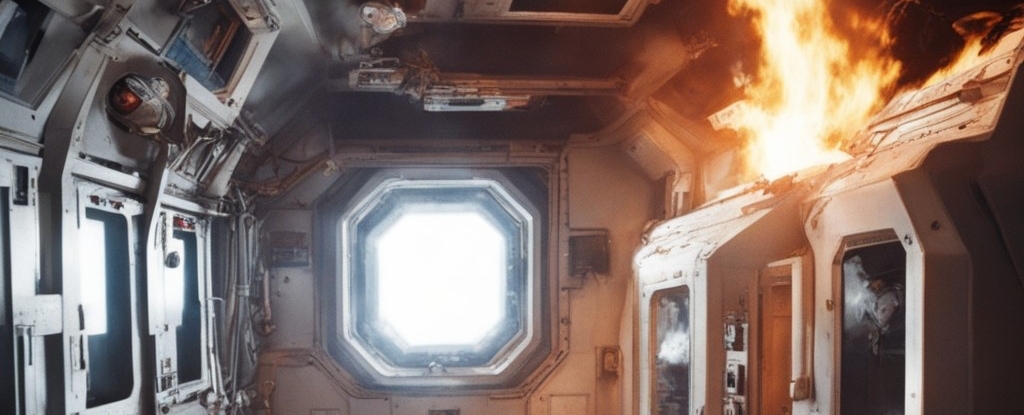Astronauts face multiple risks during space flight, such as microgravity and radiation exposure. Microgravity can decrease bone density, and radiation exposure is a carcinogen. However, those are chronic effects.
The biggest risk to astronauts is fire, since escape would be difficult on a long mission to Mars or elsewhere beyond Low Earth Orbit. Scientists are researching how fire behaves on spacecraft so astronauts can be protected.
Scientists from the Center of Applied Space Technology and Microgravity (ZARM) at the University of Bremen are investigating the risks of fire onboard spacecraft.
They’ve published a new study in the Proceedings of the Combustion Institute titled “Effect of oxygen concentration, pressure, and opposed flow velocity on the flame spread along thin PMMA sheets.” The lead author is Hans-Christoph Ries.
frameborder=”0″ allow=”accelerometer; autoplay; clipboard-write; encrypted-media; gyroscope; picture-in-picture; web-share” referrerpolicy=”strict-origin-when-cross-origin” allowfullscreen>
“A fire on board a spacecraft is one of the most dangerous scenarios in space missions,” said Dr. Florian Meyer, head of the Combustion Technology research group at ZARM.
“There are hardly any options for getting to a safe place or escaping from a spacecraft. It is therefore crucial to understand the behavior of fires under these special conditions.”
Since 2016, ZARM has been researching how fire behaves and spreads in microgravity conditions like those in the ISS.
Those conditions also include an oxygen level similar to Earth’s, forced air circulation, and ambient pressure similar to Earth’s. NASA has been conducting similar experiments, and now we know that fire behaves differently in microgravity than it does on Earth.
Initially, a fire will burn with a smaller flame and take longer to spread. This is to the fire’s advantage since it won’t be noticed as quickly.
Fire also burns hotter in microgravity, meaning that some materials that may not be combustible in normal Earth conditions could burn in spacecraft, creating toxic chemicals in the spacecraft’s air.
Spacecraft for Mars missions will have different environments than the ISS. The ambient air pressure will be lower, which provides two benefits: it makes the spacecraft lighter and also allows astronauts to prepare for external missions more quickly.
However, the lower ambient pressure introduces another critical change in the spaceship environment. The oxygen content has to be higher to meet the astronauts’ respiration needs.
In these latest tests, the team at ZARM tested fire in these revised conditions.
PMMA stands for polymethyl methacrylate and is usually called acrylic. It’s a common material used in place of glass because it’s light and shatterproof. The ISS doesn’t use it, but it’s being developed for use in future spacecraft. The Orion capsule uses acrylic fused to other materials for windows, and future spacecraft will likely use something similar.
In their experiments, the researchers lit acrylic glass foils on fire and varied three environmental factors: ambient pressure, oxygen content and flow velocity.
They used the Bremen Drop Tower to simulate microgravity.
The experiments showed that lower ambient pressure dampens fire. However, higher oxygen content has a more powerful effect. The ISS’s oxygen level is 21%, just as it is on Earth.
Future spacecraft with lower ambient pressures will have oxygen levels as high as 35%. That translates into a huge increase in the risk astronauts face from fire. The results show that a fire can spread three times faster than it would under Earth conditions.
“Our results highlight critical factors that need to be considered when developing fire safety protocols for astronautic space missions.” Dr. Florian Meyer, Combustion Technology research group at ZARM
We all know increased airflow spreads fire faster; that’s why we blow on a small flame to create a larger fire. Increased airflow delivers more oxygen, increasing combustion, so increased airflow in a higher-oxygen atmosphere creates a dangerous situation for astronauts.
“Our results highlight critical factors that need to be considered when developing fire safety protocols for astronautic space missions,” said Dr. Florian Meyer.
“By understanding how flames spread under different atmospheric conditions, we can mitigate the risk of fire and improve the safety of the crew.”
This article was originally published by Universe Today. Read the original article.




















Discussion about this post